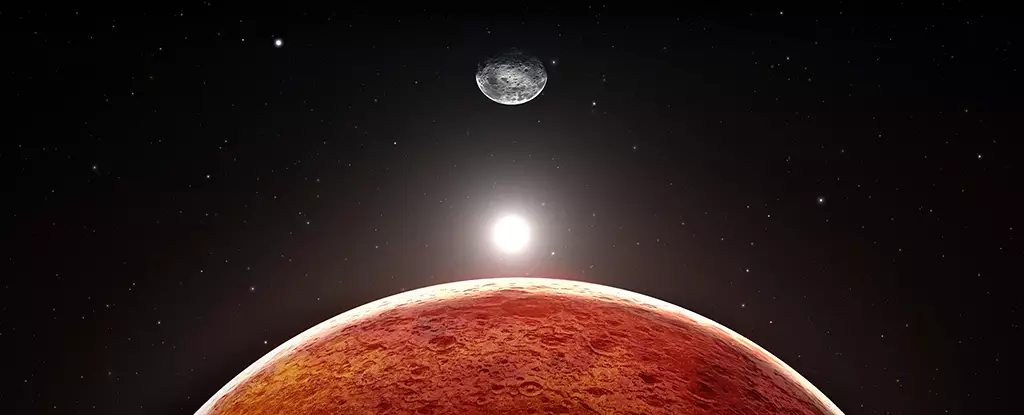Mars, often called the Red Planet, has fascinated astronomers and planetary scientists for centuries. Its peculiar shape, a triaxial ellipsoid, deviates significantly from the usual spherical forms observed in the majority of celestial bodies within our Solar System. Despite extensive research, the distinct contours of Mars have puzzled experts. A recent theory proposed by astronomer Michael Efroimsky suggests that the key to understanding this anomaly could lie in a long-lost moon, which he affectionately named Nerio after the ancient Roman goddess associated with the planet. This intriguing hypothesis not only reopens discussions about Mars’s formative years but potentially reshapes our understanding of planetary development.
The Triaxial Shape of Mars: An Anomaly in the Solar System
Mars exhibits a shape that is markedly different from its neighboring planets. Unlike Earth or Venus, both of which possess more symmetrical forms, Mars is dramatically flattened along its poles and bulging at the equator. The triaxial nature of Mars calls attention to its formation history and physical evolution, raising questions about the forces that could have contributed to this unique structure. Efroimsky’s hypothesis posits that an additional moon, orbiting at a synchronous distance, could have played a pivotal role in shaping Mars during its infancy, generating the gravitational forces necessary to mold its form into what we see today.
The Role of the Hypothetical Moon Nerio
Efroimsky suggests that Nerio, potentially one-third the size of Earth’s moon, enhanced the gravitational dynamics of early Mars. This additional mass could have caused significant geological activity by influencing the movement of molten rock within the planet. His calculations illustrate that the presence of such a moon might have initiated a seed triaxiality in Mars’s structure, where gravitational pull led to a constant state of deformation, aligning the planet’s longest axis in tandem with the moon’s orbit. This orientation would not only explain the initial shape of Mars but also contribute to the subsequent development of its geologic features.
The volcanic activity in this scenario would have played a critical role in creating the planet’s notable landmarks. Features such as Olympus Mons, the tallest volcano in the Solar System, and Valles Marineris, an expansive canyon system, could be the legacy of a more active geological past spurred by the gravitational tug-of-war with Nerio. As such, this hypothesis links celestial mechanics with planetary geology in a fascinating narrative of evolution.
Adding another layer to this exploration, Efroimsky connects the hypothetical moon’s existence to the Late Heavy Bombardment that occurred approximately 4 billion years ago. This tumultuous period saw a surge of impact events across the Solar System, which may have affected Mars’s surface significantly. Efroimsky speculates that Nerio may have met its demise in this cataclysm, scattering its remnants into space and leaving behind only Phobos and Deimos, the two diminutive moons currently orbiting the planet. This scenario begs the question: could the scars of ancient impacts and the absence of a significant moon be seen as interconnected narratives in the story of Mars?
While Efroimsky’s hypothesis offers an innovative perspective on Mars’s shape and geological history, it does not come without its criticisms and challenges. A major contention lies in the absence of concrete evidence supporting the existence of a moon as large as Nerio. There have been no definitive findings of its remnants, leading to skepticism about the hypothesis’s viability.
Nevertheless, the theory opens avenues for further research. Future explorations, whether through advanced telescopic observations or robotic missions to the Martian surface, could help detect potential isotopic signatures or geological indicators that point to ancient moons or their remnants. By piecing together these cosmic puzzles, scholars can deepen their understanding not only of Mars but also of planetary formation processes throughout our Solar System.
The theory of a long-lost moon named Nerio invites an intriguing investigation into the formation and evolution of Mars. By considering celestial dynamics and geological activity together, scientists can manipulate the fabric of planetary science, revealing the potential complexities within Mars’s past. This narrative proposed by Efroimsky may not only challenge established astronomical paradigms but also inspire new inquiries that could illuminate the mysteries of our captivating neighbor in space. Whether or not Nerio ever existed, its story serves as a compelling reminder of the cosmic forces that shape our universe.


Leave a Reply